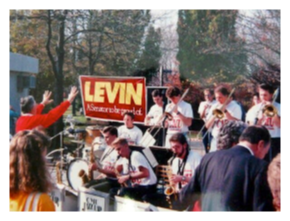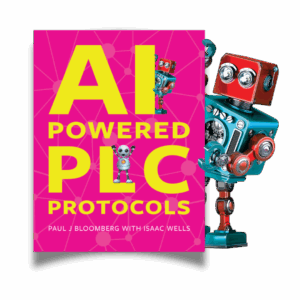Mistakes as Badges of Honor

Jazz Lab One — Mt Pleasant, Michigan
When I was deep in my saxophone playin’ days—performing from Carnegie Hall to the North Sea Jazz Festival to the World Saxophone Congress in Spain—I learned a paradoxical truth: the best musicians lean into their mistakes. In jazz improvisation, a wrong note can become a motif—if you double down and make it sound intentional. In classical performance, a cracked note can be disguised by how quickly you recover. The audience doesn’t hear a mistake; they hear momentum.
In schools, however, mistakes often get silenced, hidden, or graded away. What if we shifted? What if PLCs treated mistakes like musicians do—as raw material for discovery? That’s the spirit behind our newest AI-Powered PLC Protocol: The Mistake Protocol.
Anchored in the EAA cycle (Evidence → Analysis → Action), the Mistake Protocol takes what students do “wrong” and turns it into a badge of honor, a signal that learning is alive (Bloomberg & Pitchford, 2023).
The Science of Morale and Mistakes
What the Science Says
- Psychological safety lifts morale and learning. Teams that can surface errors without fear experiment more, learn faster, and report higher morale (Edmondson, 1999; Cannon & Edmondson, 2005).
- Error‑management cultures outperform blame cultures. Organizations that name, analyze, and learn from mistakes show better innovation and performance than those that hide errors (Van Dyck et al., 2005; Reason, 2000).
- The brain learns from errors. When learners make a mistake and receive feedback, the brain’s error‑monitoring system (ERN/Pe) activates; with a growth mindset, people show stronger post‑error adjustments and learning gains (Moser et al., 2011; Metcalfe, 2017).
- Formative assessment thrives on visible errors. Treating mistakes as evidence—then adjusting instruction—improves achievement more than grading alone (Black & Wiliam, 2009).
- Teacher morale rises with autonomy and trust. Cultures that reframe mistakes as inquiry increase professional efficacy and satisfaction (Leithwood, 2006).
- Mistake literacy equips students to learn from errors. As DeCarlo & Cohen (2025) show, students who possess both the want-to and know-how to learn from their mistakes are best positioned to leverage the most natural and unavoidable part of learning—the process itself. Their conceptual framework of mistake literacy emphasizes helping students recognize, react to, and repair mistakes as a recursive and empowering practice.
In other words: hiding mistakes drains morale while naming mistakes fuel it.
The Mistake Protocol (EAA in Action)
Step 1: Evidence
Each teacher brings in 3–5 de-identified student mistakes. These aren’t failures to hide, but artifacts to study.
Step 2: Analysis
The team digs into root causes:
- Is this conceptual? Procedural? Language-driven?
- What prior knowledge or scaffolds are missing?
- What does this reveal about how students are making sense of the idea?
Only after human sense-making do we bring in AI to cluster patterns, suggest possible misconceptions, and surface common error types across contexts.
Step 3: Action
Teams co-design re-engagement strategies:
- Instructional moves (reteach, exemplars, questions)
- Student-facing moves (self-questioning, peer feedback, practice routines)
- Equity scaffolds (UDL adjustments, multilingual supports)
Step 4: Reflection
The PLC celebrates what they’ve learned by analyzing mistakes and commits to testing one new action before the next cycle.
Framing Through the 4 PLC Questions
Clarity doesn’t come from perfection, but from how we treat mistakes. Errors aren’t setbacks—they’re signals that sharpen teaching, illuminate learning, and guide the next right move. This is how we embed mistakes into the PLC process:
- What do we want students to learn?
Mistakes clarify where the target isn’t yet visible. - How will we know if they’ve learned it?
Errors show partial understanding—better evidence than a raw score. - How will we respond when students don’t learn it?
Root-cause analysis leads to targeted, not generic, interventions. - How will we respond when students already know it?
Mistakes highlight who is ready to extend, not just who is struggling.
Peer Facilitation Prompts for PLC Leads
Here are sample facilitation moves the PLC lead can use to guide the group through the Mistake Protocol and the AI-PLC Assistant:
Step 1: Evidence
- “Let’s each share 3–5 mistakes from our students’ recent work. Remember, no names—these are artifacts, not verdicts.”
- “What might this mistake be telling us about how students are thinking?”
Step 2: Analysis
- “Where do we see patterns across our classrooms?”
- “What could be the root causes—conceptual, procedural, or language?”
- “Before we bring in AI, let’s take one more pass ourselves.”
Step 3: AI Partnership
- “Now let’s drop our mistakes into the AI-PLC Assistant. What misconceptions or clusters does it surface? How does that align—or misalign—with our own analysis?”
- “What scaffolds or strategies does AI suggest that we might adapt?”
Step 4: Action
- “What one concrete re-engagement move will we each test before our next meeting?”
- “How will we know if it worked?”
Step 5: Reflection
- “What did these mistakes teach us about student thinking?”
- “How might we celebrate mistakes with our students so they, too, wear them as badges of honor?”
Using AI Thoughtfully in PLCs
The point of AI is efficiency—it helps us surface patterns, generate ideas, and propose strategies faster. But speed is not the end goal. We still have to put our human brains on the output: to debate, adapt, and personalize ideas so they hook students in meaningful ways. Creativity counts and personalization matters.
That’s why in the PLC Mistake Protocol, the dialogue about AI output always happens via my term TAP (Teacher Analysis and Professional Dialogue)—a process I’ve developed. Grounded in John Hattie’s research on collective teacher efficacy and Andy Hargreaves and Michael Fullan’s work on professional capital, TAP ensures that every AI suggestion is filtered through professional expertise. In this way, AI becomes a catalyst for deep professional dialogue rather than a replacement for teacher judgment—strengthening both collective efficacy and the capital educators build together in practice.
The AI Prompt (Copy & Paste)
Here’s a plug-and-play prompt your PLC can use once you’ve surfaced mistakes. Just copy and paste this prompt into AI:
AI Assistant Prompt for Mistake Protocol
“I will share 3–5 de-identified student errors from recent assignments. For each error:
-
- Cluster errors by type.
-
- Suggest possible misconceptions or reasoning behind the error.
-
- Offer re-engagement moves (questions, exemplars, tasks).
-
- Flag equity scaffolds or multilingual supports that might help.
-
- Recommend one extension challenge for students who didn’t make that error.”
Honoring Mistake Literacy
I want to honor my friend Zack Cohen, whose innovative research on the concept of mistake literacy—co-authored with Mary Jean Tecce DeCarlo—offers educators a practical, research-based framework that positions mistakes as central to learning. I first met Zack at the International School of Johannesburg, and his scholarship continues to shape how I view mistakes as a powerful cultural lever for learning. Together, their work is reshaping how we understand and leverage errors in both classrooms and PLCs.
Core Processes of Mistake Literacy (DeCarlo & Cohen, 2025):
- Recognize mistakes: Notice and name errors as they occur.
- React to mistakes: Respond productively rather than shutting down.
- Repair mistakes: Revise thinking, strategies, or work to move learning forward.
These processes make mistake literacy a clear roadmap for transforming the inevitability of errors into opportunities for growth.
 Why This Matters
Why This Matters
Musicians learn to lean on mistakes until they sound purposeful. Teachers can do the same: mistakes reveal rhythm, phrasing, and openings for growth.
PLCs that embrace the Mistake Protocol build not just better instruction but stronger morale. Instead of feeling judged, teachers become researchers. Instead of hiding errors, students become explorers.
This is the kind of momentum we’re writing about in our newest book, AI-Powered PLC Protocols. And you don’t have to wait—your school can host an AI-PLC Lab, a one-day hands-on learning experience where educators run these protocols live, powered by AI, and leave ready to transform their PLCs.
It’s time to stop sorting data and start studying mistakes—together. Wear mistakes like a badge. They’re part of the soundtrack of learning.
References
- Bloomberg, P. J., & Wells, I. (2025, forthcoming). AI-Powered PLC Protocols. Mimi & Todd Press.
- Bloomberg, P. J., & Pitchford, B. (2023). Leading Impact Teams: Building a Culture of Efficacy and Agency (2nd ed.). Mimi & Todd Press.
- Black, P., & Wiliam, D. (2009). Developing the theory of formative assessment. Educational Assessment, Evaluation and Accountability, 21(1), 5–31.
- Cannon, M. D., & Edmondson, A. C. (2005). Failing to learn and learning to fail (intelligently): How great organizations put failure to work to innovate and improve. Long Range Planning, 38(3), 299–319.
- DeCarlo, M. J. T., & Cohen, Z. (2025). Learning by mistake: Constructing the conceptual framework of mistake literacy. Research in Middle Level Education, 48(7), 1–19. https://doi.org/10.1080/19404476.2025.2542672
- Edmondson, A. (1999). Psychological safety and learning behavior in work teams. Administrative Science Quarterly, 44(2), 350–383.
- Leithwood, K. (2006). Teacher working conditions that matter: Evidence for change. Elementary Teachers’ Federation of Ontario.
- Metcalfe, J. (2017). Learning from errors. Annual Review of Psychology, 68, 465–489.
- Moser, J. S., Schroder, H. S., Heeter, C., Moran, T. P., & Lee, Y. H. (2011). Mind your errors: Evidence for a neural mechanism linking growth mindset to adaptive post-error adjustments. Psychological Science, 22(12), 1484–1489.
- Reason, J. (2000). Human error: Models and management. BMJ, 320(7237), 768–770.
- Van Dyck, C., Frese, M., Baer, M., & Sonnentag, S. (2005). Organizational error management culture and its impact on performance: A two-study replication. Journal of Applied Psychology, 90(6), 1228–1240.



